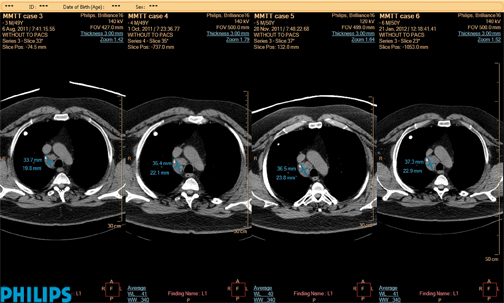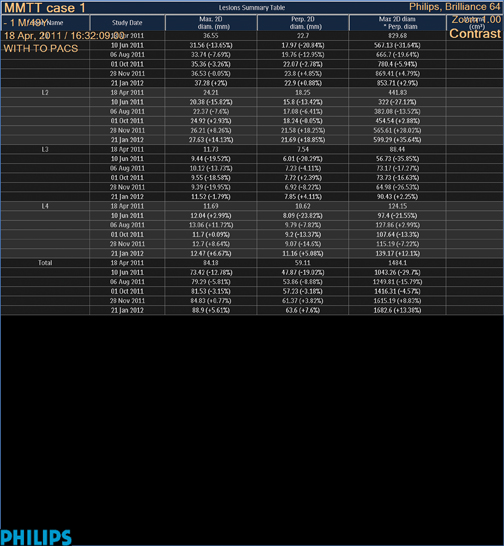IntelliSpace streamlines the continuum of care
Images



Supplement to Applied Radiology December 2012, sponsored by Philips
A multidisciplinary approach to cancer diagnosis and treatment can optimize patient care and change outcomes. Studies show that the multidisciplinary setting can be an independent predictor for improved 5-year survival compared to treatment outside of such a setting.
In oncology, there are many stakeholders throughout the process of image interpretation, measurement, monitoring, and reporting of cancerous lesions. This requires substantial data sharing and coordination.
At Franciscan Saint Francis Health, Indianapolis, IN, (Saint Francis) the radiology and oncology departments initiate the process, working closely to review and analyze multi-modality oncology datasets for tumor detection and monitoring. Since they adopted the IntelliSpace Portal, a multidisciplinary data collaboration platform by Philips Healthcare, the doctors and staff at Saint Francis have found the resulting increase in consistency and accuracy key to their success in lesion surveillance and in transforming patient care.
Streamlining lesion surveillance
Several time-consuming steps are involved in lesion surveillance. In many radiology departments, post-processing involves tracking down and loading multiple patient examinations to compare baseline to nadir scans, scrolling through a series of datasets to find the lesions and lymph nodes, measuring quantitative parameters, and calculating tumor burden based on Response Evaluation Criteria in Solid Tumors (RECIST) and World Health Organization (WHO) criteria.
At Saint Francis, radiologists were previously tasked with identifying lesions on a data sheet on the PACS and matching those with prior and current stacks of images before dictating the lesion measurements, explained J. Louis Rankin, RT (R)(MR) (PET), 3D Technical Coordinator, Imaging Services, at Saint Francis.
A complete transformation in workflow was ushered in with the introduction of IntelliSpace Portal, featuring the Multi-Modality Tumor Tracking application (MMTT). The IntelliSpace Portal is a thin-client solution for advanced image review and analysis, designed to share data across multispecialty, multimodality, and multivendor platforms. The MMTT application provides tools to decrease the time required to implement RECIST and supports datasets from CT, MR, PET/CT, and other modalities.
“The IntelliSpace Portal has automated many of these steps,” said Rankin. With the “Smart ROI,” the lesion volume as well as the maximum and minimum diameters can be measured semi-automatically. At the same time, the baseline and follow-up image series with the saved quantitative results are loaded into the MMTT application (Figure 1).
The system calculates the quantitative RECIST criteria based on percentage change in lesion diameter (Figure 2) and posts the results on the screen, plotted on a graph over time (Figure 3). All of the quantitative results are stored with the image series, which includes a summary of the results and screen shots of the lesions with treatment response categories for the oncology team to reference.
“Instead of scrolling through the data, finding the lesion, and wondering if it’s the correct target lesion, now the application does that for you,” said Rankin.
The follow-up series is automatically sent to the IntelliSpace Portal Server, also reducing substantial amounts of time.
“Once a study is in tumor tracking, it can save 20 to 30 minutes of prep time for the physician to read,” said Rankin.
The new process also cuts reading time by 5 to 10 minutes for a 5-lesion study, indicated Andrew J. Mullinix, MD, Diagnostic Radiologist at Saint Francis. “The hassle factor that it takes away is huge because you’re no longer spending a lot of time searching for the lesions when you could be adding diagnostic information,” Dr. Mullinix said.
Enhanced quality in patient care
Consumers are becoming more actively involved in healthcare decisions, thanks largely to demand for more efficiency.2
The MMTT tumor tracking application increases efficiency by enabling consistency and accuracy in lesion tracking. Dr. Mullinix said one of the most useful features of MMTT is its ability to plot a graph of the lesions over time. “Because you’re comparing the lesion to 3 or 4 or 5 prior studies, you get a nice longitudinal feel for what the tumor is doing, not just a staccato sense,” he said.
Improved efficiency can enhance quality of care. A recent patient of Dr. Mullinix presented with 2 mediastinum lymph nodes and 2 lung nodules. Dr. Mullinix was able to see, on a single graph, progressive disease in the mediastinum, but not in the lung nodules—circumstances that changed the course of treatment.
Once a radiologists completes a report, the oncology group can move forward with lesion response. The graph is especially helpful with monitoring progressive disease. “If a patient has reached 20%, he has progressive disease and must come off study,” explained Cindy Stoner, CCCP (Certified Clinical Research Professional). “With the real-time data on tumor percentage changes in tumor sizes plotted on the graph, the oncology team can better prepare patients for changes in treatments,” Stoner said
“Today, our patients are so informed about the drugs and treatment, they call for the results right after each scan. Tumor tracking has allowed us to give them more information, and prepare patients if we have to take them off study and suggest alternatives,” she added.
Consistency across disciplines
IntelliSpace Portal and the tumor tracking application have helped optimize oncological lesion surveillance by automating steps, saving time, and improving the presentation of the data.
“The workflow takes a team approach, and the IntelliSpace Portal has impacted my workflow,” said Dr. Mullinix. “It has made our workflow smoother, the lesions are easier to find, it’s easier to report, and it makes the referring physicians happy because it’s a more complete report.”
Ultimately, it is transforming the way doctors at Saint Francis deliver care.
“The best part about IntelliSpace,” said Rankin, “is the accuracy and consistency. The more accurate and consistent we are, the more volumes of data we can build up, which will help us be more accurate and concise with cases in the future.”
Citation
IntelliSpace streamlines the continuum of care. Appl Radiol.
December 10, 2012